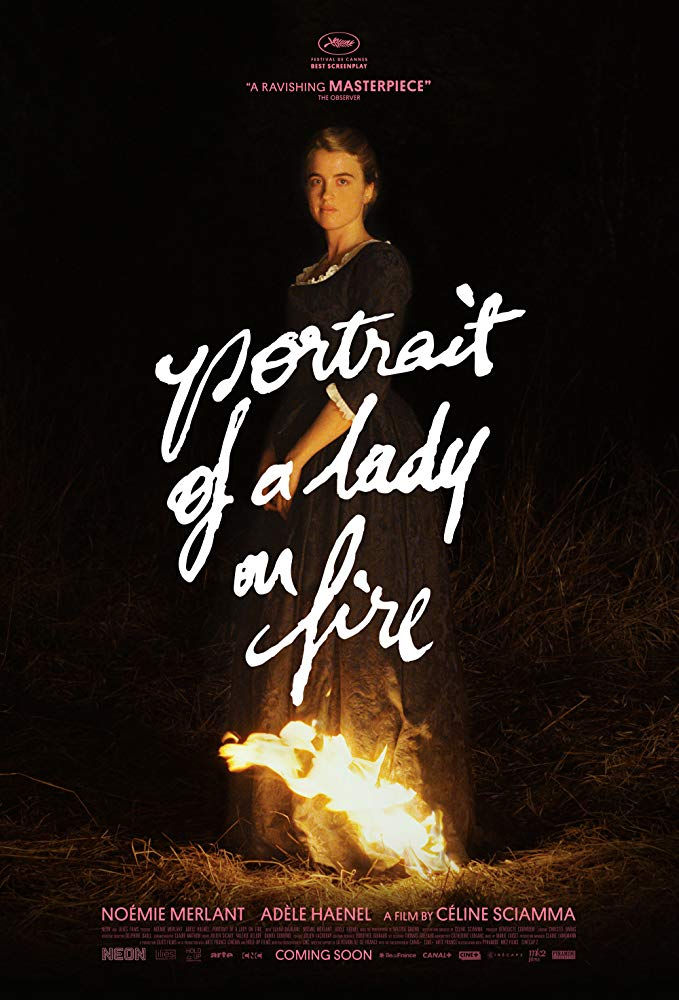Portrait of a Lady on Fire film review BFI London Film Festival 2019
- UK Film Review

- Oct 16, 2019
- 3 min read
★★★★★
Directed by: #CélineSciamma
Written by: Céline Sciamma
Starring: #NoémieMerlant, #AdèleHaenel, #LuànaBajrami
BFI London Film Festival Review by: Andrew Young

Portrait of a Lady on Fire Movie Review
Céline Sciamma’s Portrait of a Lady on Fire is a stealthily spellbinding film. It takes a pair of characters and has them inch ever closer until their love takes flight. Similarly, the film pulls in its audience with reserved yet compelling #filmmaking, only for it to catch alight and become an engrossing account of both the desire and longing involved in a love affair.
The two characters in question are Héloïse and Marianne (Adèle Haenel and Noémie Merlant), two women living in 18th century Brittany. Héloïse is a wealthy young woman who is still mourning the death of her sister some years prior to the film. Marianne is a portrait artist enlisted by Héloïse’s mother to observe the daughter under the pretence of being a female companion, but in fact painting her in secret so that the portrait can then be used to find Héloïse a husband.
This is all largely just the framework for the film’s central interplay between the two leads. Sciamma has the two of them face off, almost as if in a game of cat-and-mouse, but with the two roles continuously revolving between them. The fizzling romance and slight underlying distrust between Héloïse and Marianne forms the backbone of their artist-subject relationship. The film mines great drama from this dynamic, with their evolving relationship accelerated by their constant observations of each other in the portraiture scenes.
In Héloïse and Marianne’s ongoing battles with both their own and the other’s desires Haenel and Merlant are exceptional. The latter has a constant, compelling energy, both entranced and intimidated by Héloïse’s enigmatic gaze. Haenel, meanwhile, gives a fascinating performance that is at times remarkably still. Sciamma frames her in a statuesque way, almost ghostlike as she lurks stealthily round corners. This ethereal quality in Héloïse is one of the film’s great fascinations, and one of its great strengths too.
The majority of the narrative is a flashback, bookended by Marianne’s present-day perspective. Where a framing device can often feel superfluous, here it is crucial that we are watching the drama unfold in the form of Marianne’s memories. She is a real, vital presence in all scenes, while Héloïse’s ghostly detachment turns her into an often-elusive presence. She appears as much an idea, a haunting memory of the intense love her and Marianne once shared as a real person.
The cold, detached Héloïse also serves to remind us of the deep sadness hanging over the film, particularly in its early stages. With her sister’s death, we sense, a part of Héloïse died too, condemning her to a half-lived life, somewhere between person and ghost. Marianne’s love unlocks something in Héloïse, turning her from a spectral enigma into a real, human presence of flesh and blood. In every frame throughout this journey, the costume and set design are superb, as is the work of cinematographer Claire Mathon. All these elements are kept under masterful control by Sciamma; this is truly a beautiful, beautiful film.
Stylistically it is not an overtly audacious enterprise, but the director’s formal skill and control over her material is clear throughout. Her style of filmmaking is deceptively complex, often appearing to be a naturalistic, actor-driven approach, but with regular visual flourishes that catch the eye without deviating from the overall aesthetic. Sciamma teases us, holding visual flair and emotional bombast just below the surface, with both occasionally breaking through in audacious, breathtaking moments. One such moment is the film’s ending, a tour-de-force from both director and performer.
Sometimes Sciamma holds a shot for what feels like an age, but it is always just right. It allows us the time to appreciate the aesthetics whilst also ruminating on the characters’ place within them, probing the psyches of the two women to truly understand their feelings. As with these emotional crescendos, everything in Portrait of a Lady on Fire is very difficult to fault; every object, every frame, feels at once meticulously crafted and alive with barely concealed emotion. To have such formal precision infused with a palpable sense of wild magic is no mean feat, and it proves that Sciamma is a #filmmaker of enormous skill.
.png)




Comments